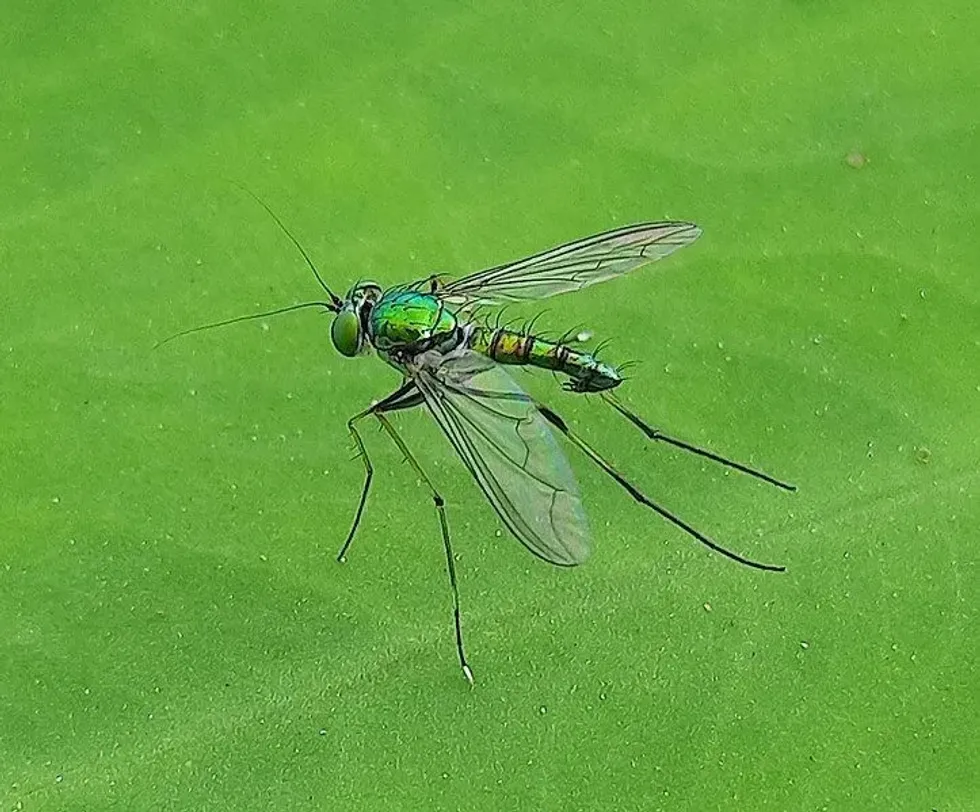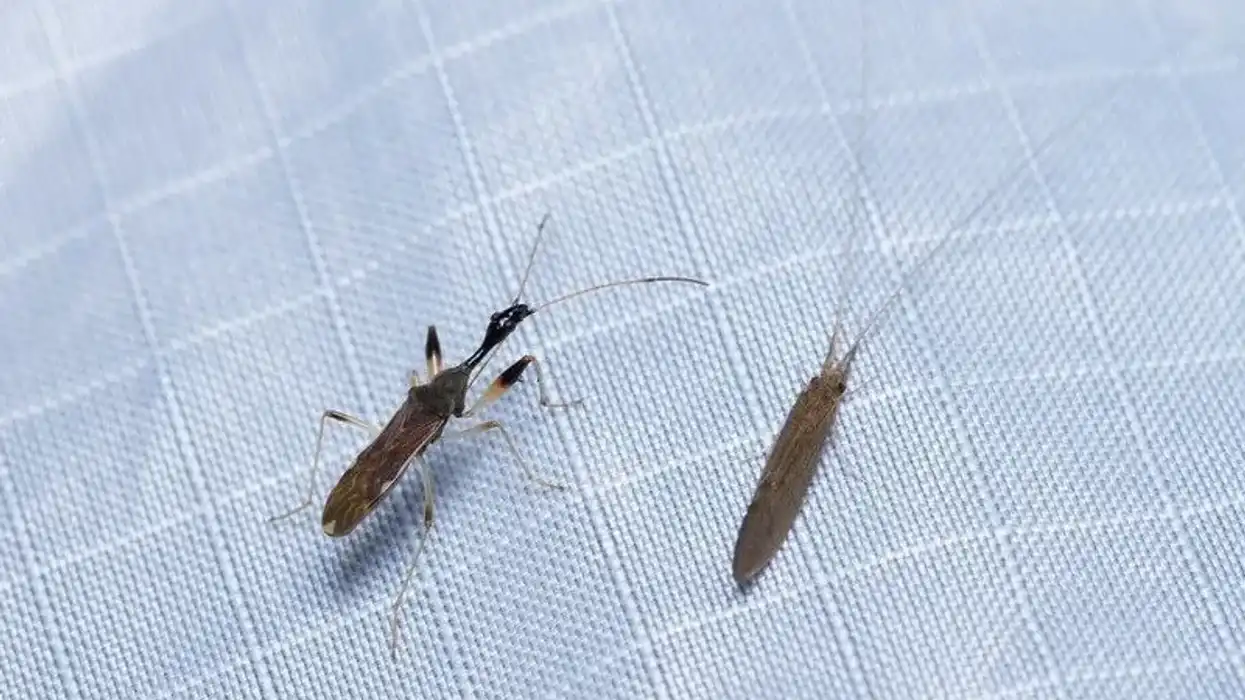Are you thrilled to know more about interesting insects like the fishfly? If yes, then you will surely be happy to read about the long-legged fly.
This is not a single fly species but rather a family known as the Dolichopodidae that contains over 7,000 fly species. It's known as long-legged because of the stilted long legs seen throughout the family.
Compared to other flies, these insects are actually seen as beneficial due to their predating on garden insects. So, they can efficiently be used as a natural pest control mechanism in gardens and forests.
One of the most interesting things about this fly is how it looks. The soft body is mainly metallic green-blue in color and looks like an oil spill.
If you aren't concentrating on it, the insect can actually appear just like a mosquito. However, you won't be able to see this fly in your house but will need to traverse into a more grassy area to catch a glimpse of it.
Keep reading if you do want to know more long-legged fly facts to share them with your friends.
Also, check out our other articles on flesh fly and mayfly to learn about the life of other insects.
Long Legged Fly Interesting Facts
What type of animal is a long-legged fly?
Long-legged flies belong to the huge fly family of Dolichopodidae from the order Diptera.
What class of animal does a long-legged fly belong to?
As a true fly, these insects belong to the class Insecta like the fishfly.
How many long-legged flies are there in the world?
We cannot possibly come up with an exact number of long-legged flies that are found in this world.
Where does a long-legged fly live?
These long-legged flies live all around the world, and there are over 7,000 species that have been found spanning over 230 genera. For instance, the green long-legged fly or Austrosciapus connexus hails from Australia. These flies aren't native to a single place.
What is a long-legged fly's habitat?
Long-legged flies may live in various habitats, but the adults are often found in grassy areas, shrubbery, meadows, woodland edges, gardens, and even in aquatic habitats. Some have also been seen in sandy or dry areas, and you can always catch flies near vegetation for feeding on insects.
While as a larva, it can be found on the soil. Some even live in tree trunks that have been damaged by bark beetles.
Who does the long-legged fly live with?
You can find these predators in groups mostly near areas where food is available, but like any other flies, these are also solitary in nature.
How long does a long-legged fly live?
We don't know the exact lifespan of this species, but as true flies, these may live for around 28 days.
How do they reproduce?
Little is known about the reproduction of these flies except the elaborate courtship done by the males to woo the females. Like other insects, long-legged flies also go through different stages in their life cycle.
The first is the larval stage, where these dolichopodids mainly live in the soil scavenging. Then it turns into a pupa and finally into adult flies that predate on other insects.
What is their conservation status?
Long-legged flies are yet to make it into any conservation lists.
Long-Legged Fly Fun Facts
What does a long-legged fly look like?
These slender soft-bodied animals with long legs are often mistaken for mosquitoes or even big black flies. However, these are flies have a metallic green-blue or metallic copper body that looks quite beautiful.
Even the wings are quite elaborate and nicely decorated. The longer legs are vital to the males, as they have cups to cover the eyes of a female during mating.
In the larvae stage, these can look similar to maggots and can be hard to identify, but the ventilation patterns on the wings help to differentiate between the species.
Moreover, you have to remember that the Dolichopodidae family is quite diverse, so the flies can also look quite different. One of the most interesting aspects of these insects is the genitalia seen in the males, which seem to hang on a petiole.

How cute are they?
We don't think that most people will find these flies cute. Having said that, the long legs and the green metallic body makes these insects which makes this species quite memorable.
How do they communicate?
Flies are known to have elaborate communication techniques where most use the legs and wings to produce vibrations. When it comes to long-legged flies, the species are also known for courtship communication that's performed visually. Other than that, most flies can also communicate by spreading certain chemicals.
How big is a long-legged fly?
The average size of long-legged flies is around 0.03-0.35 in (1-9 mm), so the insect can be tiny to medium-sized. In comparison, the yellow fly has an average size of around 0.4 in (10 mm), making it slightly bigger.
How fast can a long-legged fly fly?
There is no data about the exact flight speed of the long-legged fly species. However, we would like you to note that most flies aren't that fast. Most are just adept at getting away pretty quickly. The most common flies we see have only a speed of around 4 mph (7 kph).
How much does a long-legged fly weigh?
We don't know the exact weight of this species, but we can assume that it would be minuscule for such a small fly.
What are the male and female names of the species?
There are no separate names for the male and female of this species.
What would you call a baby long-legged fly?
A baby long-legged fly can be called a larva.
What do they eat?
Well, as the family Dolichopodidae is huge, we can't possibly know the full diet of long-legged flies. However, most are known to depend on other insect species such as aphids, spider mites, termites, and even other insects from the order Diptera.
Other than that, these flies also feed on larvae of other insects like mosquitoes, by searching for them under the bark or soil. The larvae are most likely to scavenge on food found in their surroundings.
Are they dangerous?
No, these insects aren't dangerous to a human, but if you're an insect, then it's better to stay away from the mouth of these predators.
Would they make a good pet?
No, these long-legged flies aren't the ideal pet that you might want to have. However, it's always a good idea to observe these flies collecting their prey which is truly fascinating.
Did you know...
Long-legged flies are often confused with the stilt-legged flies that belong to the Micropezidae. However, both look quite different except for the similar-looking legs. So, when you look at black flies with long legs, it can be either of the two insect families. You should know that neither long-legged flies nor stilt-legged flies bite humans.
Is the long-legged fly good for gardens?
Yes, long-legged flies are quite good for the garden. It's regarded as a natural pest control mechanism as it feeds on a lot of arthropods. In the garden, these insects help to get rid of aphids, spider mites, and larvae of other insect species.
The use of long-legged flies has been getting popular, especially in organic gardens. Even the larvae of these insects feed or scavenge on other insects. Moreover, just like other flies, the long-legged variants can also help in pollination around the garden.
Is the long-legged fly dangerous to humans?
No, these flies aren't dangerous to humans, and neither do they bite.
Here at Kidadl, we have carefully created lots of interesting family-friendly animal facts for everyone to discover! Learn more about some other insects from our potter wasp facts or European hornet facts pages.
You can even occupy yourself at home by coloring in one of our free printable Georgia insect coloring pages.
Main image by Sankar
Second image by Ryan Hodnett









